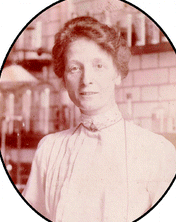Martha Annie Whiteley facts for kids
Quick facts for kids
Martha Annie Whiteley
|
|
|---|---|
 |
|
| Born | 11 November 1866 |
| Died | 24 May 1956 (aged 89) London
|
| Nationality | English |
| Alma mater | Royal College of Science |
| Awards | D.Sc. from the University of London and OBE in 1920 |
| Scientific career | |
| Fields | Chemistry |
| Institutions | Imperial College |
| Doctoral advisor | William A. Tilden |
| Doctoral students | Edith Hilda Usherwood |
Martha Annie Whiteley (born November 11, 1866 – died May 24, 1956) was an amazing English chemist and mathematician. She worked hard to help women join the Chemical Society. She is most famous for her efforts to make things fair for women in chemistry. The Royal Society of Chemistry even named her one of their "175 Faces of Chemistry."
Contents
About Martha Whiteley
Martha Annie Whiteley was born in Chelsea, London, England, on November 11, 1866. Her father was William Sedgewick Whiteley and her mother was Hannah Bargh. After her mother passed away in the 1870s, her father married Mary Bargh Turner Clark in 1880.
Martha's Education
Martha started her schooling at Kensington High School in London. This was a Girls Public Day School Trust school, which offered good education for girls at a fair price.
She then became one of the first 28 students at Royal Holloway College for Women in London. In 1890, she earned her Bachelor of Science (B.Sc.) degree in chemistry from the University of London. She stayed at Royal Holloway College to also get an honors degree in math from the University of Oxford.
Between 1891 and 1900, Martha taught science at Wimbledon High School. For the next two years, she was a science lecturer at St. Gabriel's Training College in Camberwell. During this time (1898–1902), she also did important research on chemicals called barbiturates at the Royal College of Science.
Martha's research, working with Professor Sir William Tilden, helped her earn a doctorate degree (D.Sc.) in 1902. This degree was from the Royal College of Science, which later became part of Imperial College. Her special project was about making and studying chemicals called amides and oximes. She also taught part-time at St Gabriel's Training College, which trained female teachers.
University Career
After getting her doctorate in 1902, Professor Tilden asked Martha to join the staff at the College of Science. When the college joined with the new Imperial College in 1907, she was one of only two female professional staff members. She was the first woman to become a "Reader" (a senior academic position) at Imperial College.
In 1912, Martha started the Imperial College Women's Association. This group helped women at the college work towards equal treatment in chemistry.
Martha retired from Imperial College in 1934. However, she kept working on a big book called Thorpe's Dictionary of Applied Chemistry with her co-author Jocelyn Field Thorpe. After he passed away in 1939, Martha became the main editor for twelve volumes of the book's fourth edition. She finished her work on the dictionary in 1954, when she was 88 years old!
War Work Contributions
During World War One, the chemistry labs at Imperial College were used to study samples from battlefields. Martha and her team analyzed chemicals like tear gas and other irritants.
She worked with Frances Micklethwait and six other female scientists. They even tested chemicals like mustard gas and explosives in a special experimental trench at Imperial College. This work was dangerous. Martha herself was injured while testing mustard gas. She also helped create new ways to make medicines that used to come from Germany, such as beta-Eucaine, Phenacetin, and Procaine.
In 1920, Martha received a special award called the Order of the British Empire for her important scientific work during the war.
Helping Women in Science
Martha Whiteley was well known for her efforts to achieve equality for women in chemistry. Even before starting the Imperial College Women's Association in 1912, she fought for better changing rooms for female staff and students in all departments.
In 1904, she and 19 other women asked to be allowed to join the Fellowship of the Chemical Society in London. At first, they were not successful. But in 1908, the current members voted to let women join the Chemical Society. However, women did not become full members until 1920, after a law called the Sex Disqualification (Removal) Act 1919 was passed.
After joining the society, Martha worked with another woman, Ida Smedley Maclean. Together, they started the Women's Dining Club of the Chemical Society. Martha Whiteley later became the first woman elected to the Chemical Society's Council (a leadership group).
Images for kids
See also
 In Spanish: Martha Annie Whiteley para niños
In Spanish: Martha Annie Whiteley para niños


